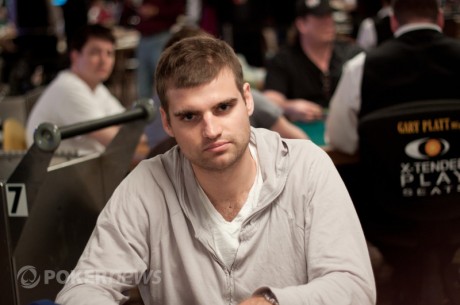20 Rounds Part I: Yakovenko's Step-by-Step Strategy Guide for Pineapple OFC Poker

Open Face Chinese has become one of the most popular games in poker. Top pros like Jason Mercier, Barry Greenstein and Shaun Deeb have become unofficial ambassadors for the game, while dozens of other pros can be found playing the game either late into the night or on their tablets. One of those players is Nikolai Yakovenko, who helped create the ABC Open Face Chinese Poker iPhone app.
Yakovenko, also known as "Googles," is originally from Moscow, Russia and is now a poker player and software developer that resides in Brooklyn, New York. After several years at Google New York working on ranking algorithms, he's been developing independent software projects ever since while making both World Series of Poker and World Poker Tour final tables. Here Yakovenko, who has $313,598 in WSOP earnings, walks you through 20 rounds of OFC (which he actually played) and offers strategy and his thought processes throughout. This is the first in a series of articles that will run every Tuesday and Thursday on PokerNews
For more on Yakovenko, check out the recent in-depth interview he did with PokerNews.
Our match starts, like many matches start, having fouled and lost the maximum against an opponent in Fantasyland.

Things were looking up as we made Aces in the middle early, with KxQx on top, ready for Fantasyland, and with J?8? on the bottom, ready to go any of a number of ways toward a straight, a flush, trips or two pair. Alas, none of these hands came in. Although we paired the jack, we soon had to abandon hope for Fantasyland on top to try to at least qualify the bottom. We played a ten on bottom for a live card, but nothing came in on the last draw.
Even if it had, we still had no chance to win the bottom or the middle. And our top could not win either, but Fantasyland with KxKx or QxQx would have softened the blow.
Let��s take stock. We��re up +1065 against the ABC computer over 634 rounds of play (counting Fantasyland rounds). That��s a win rate of +1.7 points/round. Pretty good, if a bit lucky.
Over the next several installments, I��ll talk through another 20 rounds of Pineapple OFC against the computer. In the interest of space, I don��t delve into the logic of every play, and every alternative option, but I do explain the major points of strategy that come up in OFC Pineapple matches, many of which happen to us here.
I also introduce a simple notation for recording OFC moves (Pineapple or otherwise). It��s based on standard chess notation. The point is to write down games in a clean & readable manner. There��s no standard for how to do this, so I made one up. Let me know what you think?
Round 635 (first to play) �� Beginner��s Luck

1. /// 3?5?4?2?8?
In Pineapple, we are big favorites to make the flush after a three-card-flush start. So there��s no reason to play the four-straight, which would be the other play here. Also, by playing a three-card move on the bottom, we can benefit from a lucky 8x8x9x draw on the next turn, and play trips on the bottom.
The purpose of any starting Pineapple hand is to lay the easiest path to Fantasyland. Here, our best path is to go for a flush (or trips) on the bottom, and two pair in the middle. As far as we know, all of the cards we need are live. These common themes will come up again & again.
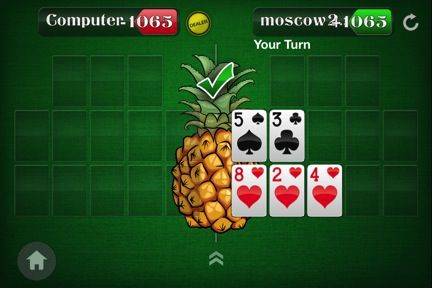
1. /5?3?/8?2?4?, Q?/A?3?/J?9?
2. /5?3?5?/8?2?4?K?/[?], Q?/A?3?8?/J?9?9?/[?]
3. /5?3?5?/8?2?4?K?/(10?A?A?)
In the interest of time, I skipped the next move�� OK I forgot to take a screenshot. My bad.
But it��s easy to see what happened here. Let��s take a second to go over the game notation. Or you can skip the notation and just follow the pictures. But the notation is useful. Give it a try. It��s not complicated.
On our first move, we played 5? and 3? in the middle, and 8?, 2? and 4? on the bottom. Nothing on top. Hence /5?3?/8?2?4?. The moves are in parentheses to show that we just played those cards, highlighting our last move.
Our opponent responded with a Q? on top, and A? in the middle, and a two-card straight flush on the bottom. All very logical. Thank you Mr. Spock.
On our second move, we got a nice draw with a heart K? on the bottom and a 5? to pair the middle. I forgot what was the third card discarded, hence that��s marked as [?]. We never know our opponent��s discards, but we can usually remember our own.
On the third move, we pull two aces, and a heart. Since we haven��t moved yet, I record these in brackets as 10?A?A?. Simple, right? I told you it wasn��t complicated.

Here I choose to complete the flush, and throw an ace up top.
It��s a pretty obvious move, and I think just about anyone would play the hand this way. Although some might play both A? & A? on top to gamble. Heck, I��d do that too in a different spot, but not here. The chances of pulling another heart AND a five or a three isn��t close to 100%, and while there are many hearts left in the deck, two of those (the 5? and the 3?) I��d need for the middle.
We could dig further, but let��s just make the obvious play here and keep going. Note that we also use two of the aces that our opponent really wants, including one ace that it doesn��t know about since we discard it.

1. /5?3?/8?2?4?, Q?/A?3?/J?9?
2. /5?3?(5?)/8?2?4?(K?)/[?], Q?/A?3?(8?)/J?9?(9?)/[?]
3. (A?)/5?3?5?/8?2?4?K?(10?)/A?

1. /5?3?/8?2?4?, (Q?)/A?3?/J?9?
2. /5?3?(5?)/8?2?4?(K?)/[?], Q?/A?3?(8?)/J?9?(9?)/[?]
3. (A?)/5?3?5?/8?2?4?K?(10?)/A?, Q?(2?)/A?3?8?(8?)/J?9?9?/[?]
4. A?/5?3?5?/8?2?4?K?10?/K?10?10?
After a move for our opponent that��s only semi-useful for his cause (the cmputer takes the lead in the middle, but that��s about it), we get another nice draw. But again, we��ll need to waste a card that we��d rather keep.
It would be silly to play the K? on top here instead of making two pair in the middle. With the tens and fives, we are scooping, and the computer has very few outs in the middle to beat our big two pair. Going from winning the hand to scooping is worth +5 points. So doubling our chance of scooping is worth a couple of points, and we more than double our chance to scoop by locking in a very strong middle hand.

1. /5?3?/8?2?4?, Q?/A?3?/J?9?
2. /5?3?(5?)/8?2?4?(K?)/[?], Q?/A?3?(8?)/J?9?(9?)/[?]
3. (A?)/5?3?5?/8?2?4?K?(10?)/A?, Q?(2?)/A?3?8?(8?)/J?9?9?/[?]
4. A?/5?3?5?(10?10?)/8?2?4?K?10?/K?
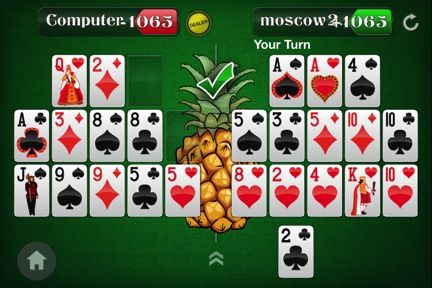
The computer improves his hand slightly, but we get a third good draw in a row and we are going to Fantasyland!
1. /5?3?/8?2?4?, Q?/A?3?/J?9?
2. /5?3?(5?)/8?2?4?(K?)/[?], Q?/A?3?(8?)/J?9?(9?)/[?]
3. (A?)/5?3?5?/8?2?4?K?(10?)/A?, Q?(2?)/A?3?8?(8?)/J?9?9?/[?]
4. A?/5?3?5?(10?10?)/8?2?4?K?10?/K?, Q?2?/A?3?8?8?/J?9?9?(5?5?)/[?]
5. A?(A?4?)/5?3?5?10?10?/8?2?4?K?10?/2?
After started with a good-not-great hand, we hit three good draws in a row and ended up with a monster.
Also, if we��d played our hand in any other way �C not that there were many options �C we could not have had a better result, and we could have easily fouled or missed Fantasyland.
Not every hand will play out so perfectly.
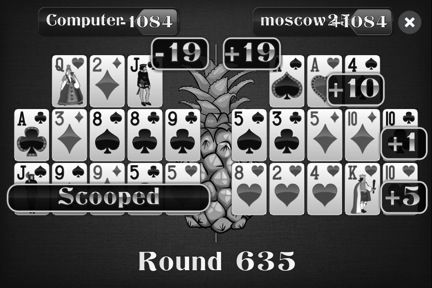
Round 636 (button, in Fantasyland) �C Fantasy, Interrupted
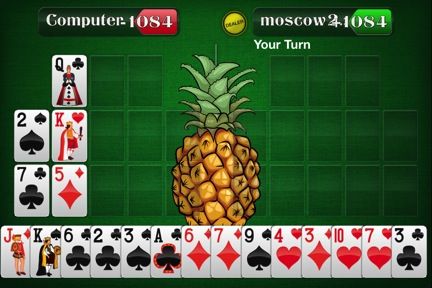
It��s not the best Fantasyland hand I��ve ever seen, but it is one of the simplest to play.

Full house on the bottom is all we��ve got. Let��s hope the computer fouls and we win our maximum of +12 points.
1. Q?/2?K?/7?5?, A?K?J?/7?7?10?9?4?/3?3?3?6?6?/2?

��and the computer got there. Although it was drawing blind, we knew that after the second move we were in trouble. All that our silicone friend needed was a 4x or 9x for the bottom straight �� all but one of which were live �� and a live Qx for the top.
This isn��t an article about odds, but let��s just say his odds of hitting the straight and the queen at that point were about 50/50. Even a bit higher perhaps.
Round 637 (first to act, defending against Fantasyland) �C Viva La Resistance!
And so, the shoe is on the other foot; it is our turn to defend again Fantasyland.

1. /2?2?4?/7?10?
Not the best hand with which to start our defense, but an easy one to play.
I call a hand like this one a ��perfect pyramid" �� every card in the middle is smaller than every card on the bottom. On the bottom, we can go for any pair or any straight draw, while rushing to make two pair in the middle, or perhaps trips in the middle if we��re feeling frisky and are live.
Big cards will go on top. Hopefully we make a quick two pair on bottom, two pair in the middle, with a freeroll for Fantasyland on top.

1. /2?2?4?/7?10?, (???)/(?????)/(?????)/[?]
2. /2?2?4?/7?10?/7?K?Q?
And the perfect pyramid continues to grow.
We have no idea whether the king or the queen is more live, so we play the bigger bonus card up top. There is no scenario where one big pair qualifies, and the other doesn��t.

1. /2?2?4?/7?10?, (???)/(?????)/(?????)/[?]
2. (K?)/2?2?4?/7?10?(7?)/Q?, ???/?????/?????
3. K?/2?2?4?/7?10?7?/9?4?9?
There��s some optionality here, but I always play this the same way.
It��s much harder to make two pair in the middle than on the bottom. Why? Because trips on the bottom are good, while trips in the middle often foul you. With a king on top, live as far as we know, it��s most important to proceed toward our perfect pyramid.
So far it��s looking good.

And then we get pull three blanks.
1. /2?2?4?/7?10?, (???)/(?????)/(?????)/[?]
2. (K?)/2?2?4?/7?10?(7?)/Q?, ???/?????/?????
3. K?/2?2?4?(4?9?)/7?10?7?/9?, ???/?????/?????
4. K?/2?2?4?4?9?/7?10?7?/3?5?8?
With only four rounds of play after the first five cards, a single round of no help will often sink a hand. Our perfect pyramid is ruined, and we��re suddenly in danger of fouling the hand, while also down to one draw to pull a king for Fantasyland.
Since all three blanks are equally live as far as we know, we put the biggest one on top for the big pair bonus, and a random one on the bottom to help with two pair.
With a perfect draw we could still return to "The Land."

Well at least we catch two pair on the bottom & don��t foul.
1. /2?2?4?/7?10?, (???)/(?????)/(?????)/[?]
2. (K?)/2?2?4?/7?10?(7?)/Q?, ???/?????/?????
3. K?/2?2?4?(4?9?)/7?10?7?/9?, ???/?????/?????
4. K?|(8?)/2?2?4?4?9?/7?10?7?(5?)/3?, ???/?????/?????
5. K?8?/2?2?4?4?9?/7?10?7?5?/2?10?4?

We win the middle to avoid a scoop. Which against a pretty strong Fantasyland hand isn��t so bad.
Kind of like holding the Miami Heat under 100 points in a loss. If only the NBA counted goal differential.

Check back on Thursday for even more great Pineapple OFC strategy as Yakovenko's match continues.
Get all the latest PokerNews updates on your social media outlets. Follow us on Twitter and find us both Facebook and Google+!

